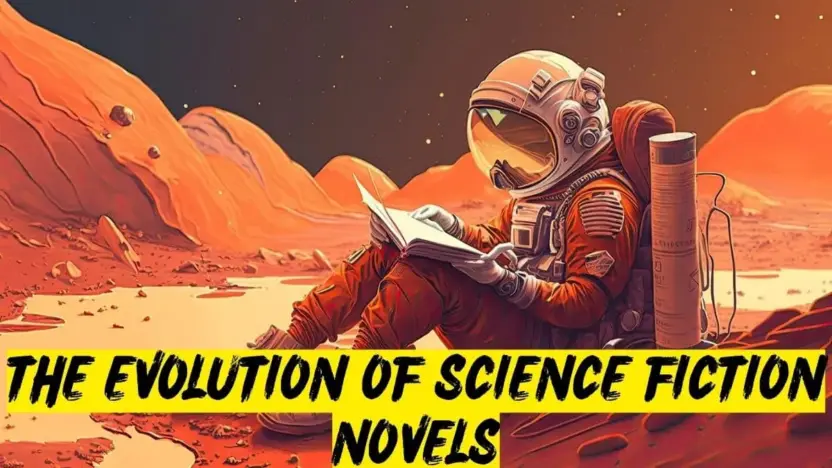Science fiction, a genre that tantalizes the imagination with visions of the future and the unknown, has undergone significant evolution since its inception. From the speculative tales of ancient times to the cutting-edge narratives of the digital age, science fiction has mirrored humanity’s understanding of the universe and its place within it. This article explores the journey and the evolution of science fiction novels through time.
The Evolution of science fiction Novels
Early Beginnings: Fantastical Voyages and Mythical Technologies

Long before the term “science fiction” was coined, stories that we might now classify under the genre were being told. Ancient epics like the Sumerian Epic of Gilgamesh and Indian texts such as the Ramayana, with its vimanas (flying machines), laid the foundational stones of speculative fiction.
These stories, rich with fantastical elements, venture into what might be considered early science fiction themes, including advanced technology and space travel. However, the absence of a scientific framework places these narratives closer to fantasy in the modern classification of genres.
The Seeds of Modern Science Fiction: Satire and Speculation
The seeds of science fiction can be traced back to ancient civilizations, where myths and stories ventured into the realms of the fantastical and the cosmic. However, it wasn’t until the 17th and 18th centuries that the genre began to take a recognizable shape with works like Johannes Kepler’s “Somnium” and Voltaire’s “Micromégas.”
The true cornerstone of science fiction, however, was Mary Shelley’s “Frankenstein” (1818), often cited as the first science fiction novel. Shelley’s masterpiece explored themes of scientific ambition, creation, and responsibility, setting a precedent for future sci-fi works to blend scientific exploration with profound ethical questions.
The later works of Jules Verne and H.G. Wells solidified the genre’s foundations, with Verne’s adventures emphasizing accurate scientific detail and Wells’s stories, such as The War of the Worlds, delving into speculative future scenarios and the human condition.
The Golden Age of Science Fiction

The early 20th century, particularly the 1930s to the 1950s, is considered the Golden Age of Science Fiction. This era was marked by the emergence of magazines like “Amazing Stories” and “Astounding Science Fiction,” which played crucial roles in shaping the genre. Editors like Hugo Gernsback and John W. Campbell encouraged writers to explore scientific ideas and their potential consequences.
During this period, authors like Isaac Asimov, Arthur C. Clarke, and Robert A. Heinlein came to prominence. Their works, including Asimov’s “Foundation” series, Clarke’s “Childhood’s End,” and Heinlein’s “Stranger in a Strange Land,” pushed the boundaries of the genre, introducing complex narratives that explored sociopolitical themes, space exploration, and advanced technologies.
The New Wave Movement
The 1960s and 1970s witnessed the New Wave movement, characterized by a shift towards more literary and experimental approaches to science fiction. This movement sought to break from the conventions of the Golden Age, incorporating more complex narrative techniques and deeper psychological and sociological themes.
Authors like Harlan Ellison, Philip K. Dick, and Ursula K. Le Guin led this charge, challenging readers with stories that questioned reality, identity, and society. Dick’s “Do Androids Dream of Electric Sheep?” and Le Guin’s “The Left Hand of Darkness” exemplified the New Wave’s emphasis on character development and social commentary, expanding the scope of science fiction beyond technological wonders.
Cyberpunk and the 1980s

The 1980s saw the rise of cyberpunk, a subgenre that melded the advanced technological landscapes of the future with the gritty elements of noir. William Gibson’s “Neuromancer” is often hailed as the quintessential cyberpunk novel, painting a dystopian world where data is the ultimate commodity, and cybernetics blur the line between human and machine.
Cyberpunk reflected the growing anxieties and fascinations of a society on the brink of the digital age, exploring themes of artificial intelligence, corporate dominance, and cybernetic augmentation. This era brought science fiction into the realm of the near-future, focusing on the immediate implications of emerging technologies.
The Expansion of the Genre in the 21st Century
The turn of the millennium has seen science fiction novels embrace an unprecedented diversity of voices and perspectives. The genre has become a vibrant tapestry that includes a wide range of cultural, gender, and socio-political viewpoints. Authors like N.K. Jemisin, with her “Broken Earth” series, and Liu Cixin, with “The Three-Body Problem,” have pushed the boundaries of traditional science fiction, incorporating complex narratives that explore themes of environmental catastrophe, cultural heritage, and the cosmic perspective on humanity.
The 21st century has also seen the rise of cli-fi (climate fiction), a subgenre that tackles the implications of climate change, and speculative fiction that explores parallel universes and the multiverse, reflecting the latest theories in physics and cosmology.
The Future of Science Fiction Novels

As we look to the future, science fiction novels continue to evolve, driven by the rapid pace of technological advancement and the changing dynamics of our society. Virtual reality, artificial intelligence, and space exploration remain fertile grounds for exploration, while emerging themes such as bioengineering, nanotechnology, and quantum computing promise to fuel the imaginations of writers for years to come.
Moreover, the increasing collaboration between scientists and authors suggests a new era of science fiction that not only entertains but educates, raising awareness about the ethical, philosophical, and practical implications of future technologies. As humanity stands on the cusp of new discoveries and challenges, science fiction novels will undoubtedly continue to serve as a critical mirror reflecting our hopes, fears, and ethical dilemmas.
This collaboration has the potential to create a more informed readership, capable of engaging with complex scientific concepts and contributing to the societal dialogue surrounding technological development. Through its unique blend of imagination, science, and speculative thought, science fiction will continue to captivate readers, challenge our assumptions, and inspire us to envision and shape a better future.
Also Read: Different Ways of Time Travel in Science Fiction



